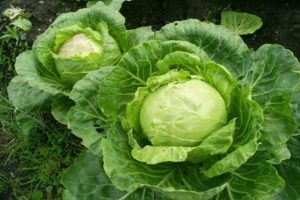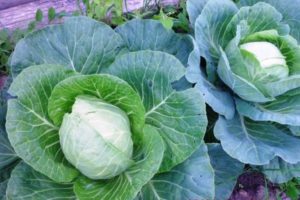Description of cabbage diseases in the open field, treatment and control of them
Quite often you can find cabbage in the gardens of many vegetable growers. This vegetable attracts attention for its taste and medicinal properties. Not all of its varieties have good disease resistance, so cabbage seedling diseases often have to be treated. However, this is not easy to do, so it is recommended to first study cabbage diseases and their treatment.
White rot
It is one of the most common diseases affecting cabbage. The main reasons for its occurrence are sharp temperature drops and high humidity. The disease begins to manifest itself during storage of vegetables and at the final stage of the growing season. Most often, the disease appears in frozen heads of cabbage.
Defining white rot is pretty simple. To do this, it is enough to carefully examine the plant. White spots, gray bloom appear on the affected leaves. Then the leaves begin to deform. It is necessary to get rid of the affected leaves immediately so that the disease cannot spread further.
Not everyone knows what to do to prevent white rot. To do this, you should adhere to the following recommendations:
- you need to store the cabbage crop at a temperature of about 1 degree Celsius;
- before storage, the premises in which the vegetable will lie must be disinfected;
- you need to plant cabbage in the previous place only after 3-5 years.
For a more detailed study of white rot, it is recommended that you familiarize yourself with the photo of the cabbage disease and the fight against it in the open field.
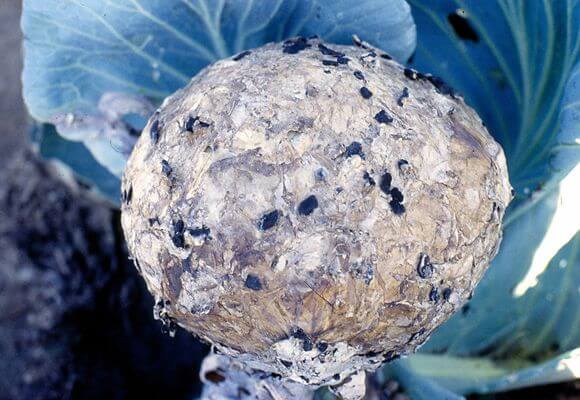
Keela
Many consider the kilu to be the main enemy of all varieties of cabbage... Most often it occurs in the ground with a high level of moisture. This disease can appear after transplanting plant seedlings into open ground. In this case, the first symptoms begin to appear very slowly. First, the leaves that are located below wilt. Later they are deformed, die off and the cabbage stops developing further.
The roots of the bushes also suffer from the keel. Over time, small growths appear on them, which gradually increase. Because of this, a malnutrition occurs and the plant completely dies. If you do not get rid of the dead bushes in a timely manner, the pathogens will enter the soil.
This cabbage disease affects bushes at any age, but most often it appears in young seedlings.
Every gardener should know how to deal with keel. When the first symptoms appear, you should immediately get rid of all affected bushes. To do this, they should be dried in the sun and burned away from the garden. Healthy cabbage is watered with not too cold water and spud.It is also recommended to dig up the soil and place the beet tops in it. Work should be carried out with separate pre-disinfected equipment.
To get rid of this disease, other measures are taken to combat it. Some gardeners carry out soil disinfection for this. The essence of this method is to plant crops on the site that destroy pathogens. To do this, you can plant garlic, onions, eggplant, pepper, tomato and spinach.
After the site is rehabilitated, it is recommended to check the soil for the presence of a disease. The plot is planted early cabbage... If during cultivation no growths appear on its roots, then we can assume that there is no keel on the site.
Blackleg
Not everyone knows why plants have a black leg. There are several reasons for this cabbage disease. These include:
- Fungi. These pathogens most often enter the ground from cabbage plants that suffered from black leg a year ago.
- High humidity and acidity. In humid air, the disease progresses much faster than under normal conditions.
- Incorrect fit. If the cabbage seedlings were planted too densely and overfed with fertilizers with nitrogen, then the likelihood of the appearance of a black leg increases several times.

In terms of its manifestation, the disease resembles cabbage Alternaria. The main symptoms include the fact that the decay process begins on the leaves of cabbage and on its stems. Blackleg is very dangerous as it spreads quickly between plants.
It is recommended to figure out in advance how to deal with it in order to protect healthy seedlings. First you need to get rid of pathogens in the soil. To do this, the soil with plants is treated with copper sulfate and watered with heated water. You can also get rid of the black leg with the help of Fundazol or Planriz. If the treated plants do not recover over time, then they will have to be removed from the garden and burned.
Fusarium
Fusarium wilting of cabbage occurs due to fungi that are in the soil. Most often, this disease occurs in young seedlings of cauliflower or cabbage, growing at very low temperatures.
It is very easy to notice the disease, as it manifests itself almost immediately. First, cabbage leaves cover yellow spots, which eventually lead to complete wilting of the leaves. Due to the infection, new heads of cabbage are not tied and the plant stops developing.
Fusarium cabbage is not amenable to treatment, so there are no effective methods of dealing with them. The only thing a person can do is to remove all infected bushes so that the infection does not spread further. You can also treat the area with copper sulfate for prevention.
Gray rot
Most often, gray rot affects cabbage at the time of storage of fruits and during their transportation. Its main causative agent is the fungus Botrytis, which can be found on dead tissues or simply in the ground.
Favorable conditions are needed for the development of the fungus - high humidity and slight frosts. Gray rot begins to spread from the lower leaves. Their surface is covered with inclusions of gray, which gradually spread to neighboring sheets.

It is impossible to cure the disease, therefore everything must be done to prevent it from appearing. There are several preventive measures that will protect bushes from gray rot:
- water the cabbage only heated and well-settled water;
- do not use fertilizers that contain a lot of nitrogen;
- harvest on time;
- do not leave the remains of the plant in the garden after collecting the heads of cabbage;
- wipe the cabbage dry before sending it for storage;
- store cabbage indoors with a temperature of about 2-5 degrees Celsius;
- before storing cabbage, you need to take care of disinfecting the room.
Mosaic
Cabbage mosaic is one of the most serious viral diseases that can occur in this plant. Infection is facilitated by improper processing of bushes or infected crops that are nearby. Quite often, a mosaic appears after picking young seedlings. Also, the disease is transmitted by various insects, which include thrips, ticks, bugs and aphids.
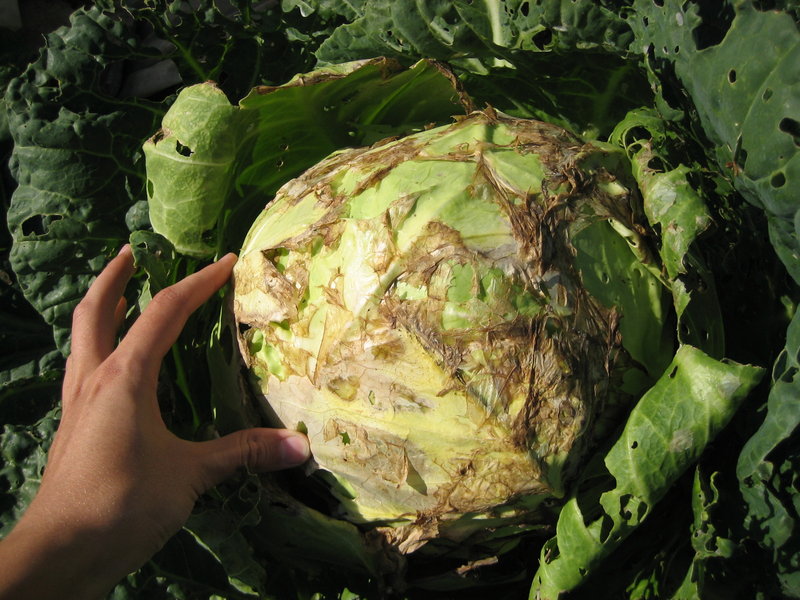
There are several main signs of the manifestation of this disease:
- The leaves are deformed and covered with spots of different colors. They can be purple or even have a lilac whitish tint.
- The development of the bushes slows down several times due to metabolic problems. As a result, young shoots begin to dry out and completely die.
- The bushes are covered with brown markings, which gradually begin to rot.
Many people think about how to treat cabbage from diseases. Treating infected bushes will do nothing, as this disease cannot be cured. It is recommended to engage in prevention, which consists in the timely destruction of weeds in the beds and various harmful insects.
Downy mildew
Peronosporosis of cabbage actively develops at temperatures above 20 degrees Celsius. After planting seedlings in the garden, the disease slows down. However, this does not prevent the fungus from continuing to maintain its viability.
The first symptoms begin to appear with the onset of warm weather. Light leaves and leaf veins are covered with scab. Also, spots of a reddish tint appear on their surface. Over time, gray patches and yellow or white spots appeared on them. Affected bushes begin to fade gradually. To learn more about the symptoms of downy mildew on cabbage, below is a photo of infected bushes.
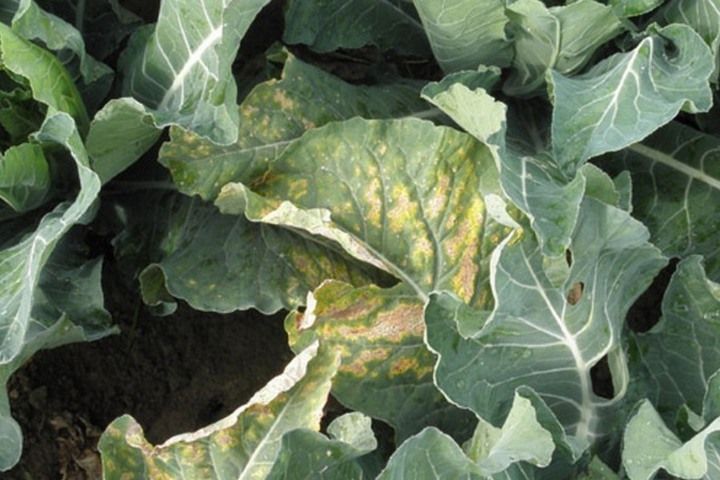
There are no effective treatments for peronosporosis. The fight against him is to timely harvest the bushes and create the best growing conditions.
To prevent the disease, it is recommended to process the seeds before planting. They are placed in hot water for half an hour, after which they are treated with Planriz.
Mucous bacteriosis
The disease gets its name because infected bushes begin to become covered with mucus. This bacterial disease can appear on cabbage during storage or growing. Quite often, it appears in conditions of elevated ambient temperatures. The main reasons for the appearance of bacteriosis include:
- increased air humidity;
- abuse of fertilizers with nitrogen;
- violation of crop rotation.
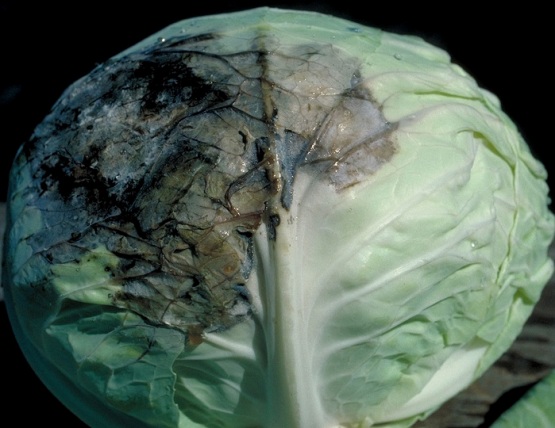
There are several options for the course of this disease. Slimy bacteriosis of cabbage can infect the outer leaves. They undergo deformation and acquire a not very pleasant smell. After a while, the disease spreads to the head of cabbage and the bush gradually dies. During infection of cabbage, the disease immediately spreads to the head of the plant.
In the second option, rotting begins with the stump. The bacterium enters it from the soil or is carried by harmful insects. Then the disease spreads to the inner leaves, which change their color and become softer.
There are different ways to prevent the disease:
- store heads of cabbage correctly;
- fight pests throughout the year;
- grow only those varieties that are resistant to mucous bacteriosis;
- disinfect planting material before sowing;
- the storage for cabbage is being processed.
Vascular bacteriosis
Quite often, pathogens of the disease fall on the bushes during rain or with the help of various insects. Moreover, vascular bacteriosis of cabbage appears at any stage of development.
The first signs begin to appear at the edges of the leaves. They begin to gradually turn yellow and dry. Sometimes they turn black and a mesh forms on their surface. When cutting the leaves, you can see that their vessels are also colored black. Within a few days, the head of cabbage is deformed, and the wilting leaves begin to fall off.

To treat this disease, you can use folk remedies:
- Zelenka with water. The bushes are treated with a weak solution prepared from 15 drops of brilliant green mixed with a bucket of water.
- Zelenka with iodine. This mixture is very effective in fighting disease. To prepare it, the green stuff is mixed with iodine in a 1: 2 ratio and diluted with 10 liters of water.
Conclusion
Prevention and control of cabbage diseases will help to get a good harvest. To cure diseases, it is necessary to study their description and treatment in advance.
